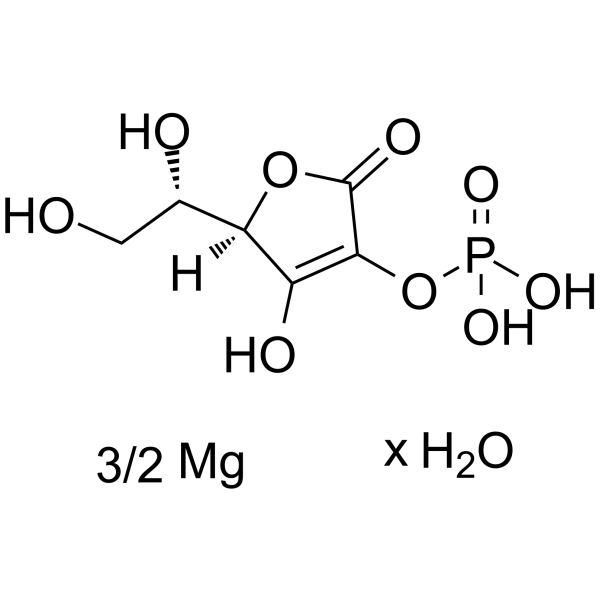L-Ascorbic Acid 2-phosphate (magnesium salt hydrate)
Modify Date: 2025-08-24 13:05:01

L-Ascorbic Acid 2-phosphate (magnesium salt hydrate) structure
|
Common Name | L-Ascorbic Acid 2-phosphate (magnesium salt hydrate) | ||
|---|---|---|---|---|
| CAS Number | 1713265-25-8 | Molecular Weight | N/A | |
| Density | N/A | Boiling Point | N/A | |
| Molecular Formula | C12H12Mg3O18P2·xH2O | Melting Point | N/A | |
| MSDS | N/A | Flash Point | N/A | |
Use of L-Ascorbic Acid 2-phosphate (magnesium salt hydrate)L-ascorbic acid 2-phosphate (2-Phospho-L-ascorbic acid) magnesium hydrate is a long-acting vitamin C derivative that can stimulate collagen formation and expression. L-ascorbic acid 2-phosphate magnesium hydrate can be used as a culture medium supplement for the osteogenic differentiation of human adipose stem cells (hASCs). L-ascorbic acid 2-phosphate magnesium hydrate increases alkaline phosphatase (ALP) activity and expression of runx2A in hASCs during the osteogenic differentiation[1][2][3]. |
| Name | L-Ascorbic Acid 2-phosphate (magnesium salt hydrate) |
|---|---|
| Synonym | More Synonyms |
| Description | L-ascorbic acid 2-phosphate (2-Phospho-L-ascorbic acid) magnesium hydrate is a long-acting vitamin C derivative that can stimulate collagen formation and expression. L-ascorbic acid 2-phosphate magnesium hydrate can be used as a culture medium supplement for the osteogenic differentiation of human adipose stem cells (hASCs). L-ascorbic acid 2-phosphate magnesium hydrate increases alkaline phosphatase (ALP) activity and expression of runx2A in hASCs during the osteogenic differentiation[1][2][3]. |
|---|---|
| Related Catalog | |
| In Vitro | L-Ascorbic acid 2-phosphate (0.1-1.5 mM; 2 to 3 weeks with medium exchange every 2 to 3 days) magnesium hydrate significantly stimulates cell growth, whereas addition of l-Ascorbic acid (Asc) achieves only weak growth stimulation. A combination of Asc-2P and bFGF significantly increases cell growth, but supplementation with EGF and/or insulin does not have any additional effect [1]. L-Ascorbic acid 2-phosphate (50 µM-250 µM) magnesium hydrate is needed for the effective osteogenic differentiation of human adipose stem cells (hASCs), and higher concentrations of AsA2-P results in increased runx2 expression and ALP activity. The highest proliferation, ALP activity and runx2 expression is achieved with 150 µM AsA2-P and 10 nM dexamethasone (Dex), and 250 µM AsA2-P and 5 nM Dex[3]. Cell Proliferation Assay[1] Cell Line: Human corneal endothelial cells (HCECs) Concentration: 0.1 mM; 0.3 mM; 1.5 mM Incubation Time: 2 to 3 weeks with medium exchange every 2 to 3 days Result: Stimulated HCEC cells growth. |
| References |
| Molecular Formula | C12H12Mg3O18P2·xH2O |
|---|---|
| InChIKey | FXAHLSPFUCDHOV-IXNKEUJHSA-N |
| SMILES | O.O=C1OC(C(O)CO)C(O)=C1OP(=O)(O)O.O=C1OC(C(O)CO)C(O)=C1OP(=O)(O)O.[Mg].[Mg].[Mg] |
| MFCD03428049 |